

 |
||
 |
||
Vol. 10 (2): November 2007 |
||
Algeria / Croatia / Greece / Madeira / Mauritania & Western Sahara / Morocco / Turkey
Madeira
|
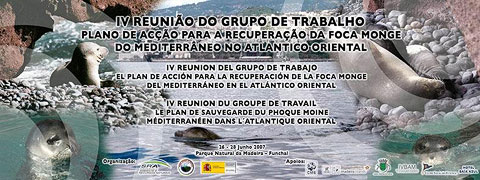 |
|
|
The meeting was attended by members of the Working Group from Mauritania, Morocco, Portugal and Spain as well as one representative from the Bonn Convention.
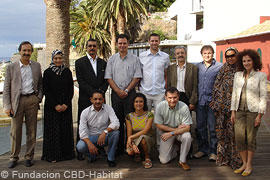 |
|
|
Meeting participants in Funchal. |
With earlier meetings having established the Action Plan, the objective of this latest meeting was to define and agree the priority actions to be funded for the conservation of this species in each participating country.
The first part of the agenda featured presentations about the conservation status of the Atlantic monk seal populations, as well as monitoring and research conducted in Madeira and in Cabo Blanco. In a second part, the working group defined the priorities for each country in the period 2008-2010, which were successfully agreed by all. These priorities include:
The meeting ended with a visit to the Desertas Islands Nature Reserve on the Parque Natural da Madeira’s sailing ship “Buteo”, allowing participants of the meeting close contact with the reality of the islands in terms of monk seal habitat and work done to monitor the species. – Rosa Pires, Parque Natural da Madeira and Pablo Fernández de Larrinoa, Fundación CBD-Habitat.
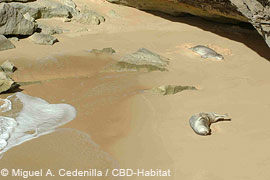 |
|
|
Seals hauled out at Playa Halcón, 18 October 2007. |
In Cabo Blanco, as in most parts of their distribution range, monk seals use the beaches of marine caves to haul out and breed. As is commonly known in monk seal conservation circles, this is not their original habitat, human persecution, disturbance and habitat destruction having led them to abandon open beaches.
Up until today, only in Madeira, after years of strict protection of the Desertas Islands Nature Reserve, and in a remote and isolated island in Greece, have seals used open beaches for basking and even rearing their pups.
In the Cabo Blanco peninsula, home to the largest aggregation of monk seals in the world, only a few adult male monk seals have been known to use open beaches, protected by cliffs, to haul-out in areas far away from the breeding caves of the colony. Following Madeira’s experience, and within the framework of the Action Plan for the Monk Seal in the Atlantic, in 2001 CBD-Habitat Foundation, in collaboration with local and regional authorities and artisanal fishermen, created a strict protection reserve to protect the breeding caves and vicinity.
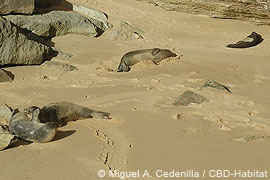 |
|
|
Seals on Playa Halcón, including mother with pup, 29 October 2007. |
After 6 years of strict protection and elimination of threats and disturbance – including the presence of fishermen and the setting of fishing gear, and from land, goose barnacle collectors – monk seals are reacting as expected. In the last two years, more and more seals have been using open beaches inside the reserve and in the vicinity of the breeding caves. In the beginning, only adult males were observed; in fact, more than 6 identified adult males are currently using different beaches of the area, one of them reoccupying Morales beach, where D. Eugenio Morales Agacino discovered this monk seal population in 1945, and where Jacques Cousteau captured two youngsters a few years later. Previously, there had been no evidence of monk seals using this beach since the 1950s.
Even more importantly, since October 2006 several younger animals, juveniles, subadults, and pups with their mothers have been observed occupying an open beach very near to the vicinity of one of the breeding caves.
This trend in reutilization of open beaches for basking is another good sign of the progressive recovery of the Cabo Blanco monk seal colony. – Pablo Fernández de Larrinoa, Mercedes Muñoz and Hamdi M’Barek, CBD-Habitat.
On 23 August the guard of a local sports club observed a seal resting over a rock at a little breakwater at Cansado bay, 7km south from the city of Nouadhibou, at the Cabo Blanco Peninsula. Alerting the Mauritanian Oceanographic and Fishing Investigation Institute (IMROP), and the CBD-Habitat foundation, technicians from both institutions arrived at the scene, where they found and identified the animal as a subadult or juvenile female grey seal (Halichoerus grypus). The individual was found in the water a few meters away from shore displaying “bottling” behaviour typical of the species. The seal seemed at first sight in good physical condition, without wounds or hair loss. The coloration was white with black patches and its length was estimated at around 1.5m.
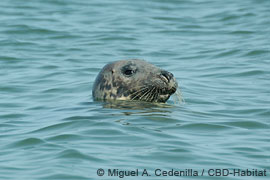 |
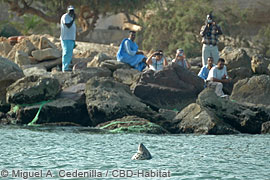 |
|
|
|
|
Technicians from both institutions agreed to attempt a capture of the animal in order to check its health and for possible infectious diseases, because of the potential danger that could represent for the monk seals of the Cabo Blanco peninsula. However, after several days of searching to effect the capture, the seal did not reappear in the area. This observation is believed to be the first of grey seal at this low latitude. – Miguel Angel Cedenilla and Moulaye Haye, Fundación CBD-Habitat.
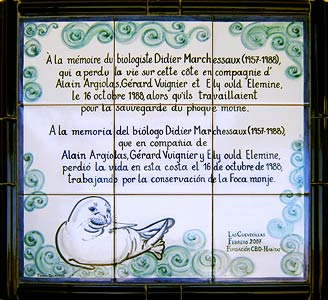 |
|
|
|
Last February a small commemoration took place at CBD-Habitat’s Biological station ‘Las Cuevecillas’ at the ‘Costa de las Focas’ (Coast of Seals) reserve, in which the memory of Didier Marchessaux was honoured, along with his colleagues Alain Argiolas, Gérard Vuignier and Ely ould Elemine. The researchers had been working towards the protection of the monk seal colony, when their vehicle was involved in a tragic landmine accident. – Miguel Angel Cedenilla, Fundación CBD-Habitat.
CBD-Habitat Foundation and the National Park of Banc D’Arguin are jointly developing a cooperation project to improve the surveillance and communication strategy of the Satellite Reserve of Cap Blanc.
This protected area, located at the tip of the Cabo Blanco peninsula, was created in 1986 with the objective of protecting the adult male monk seals that used its beaches and surroundings waters. Sadly, after the mass die off that reduced the Cabo Blanco monk seal population to one third of its former strength in 1997, only one adult male continued using Satellite Reserve.
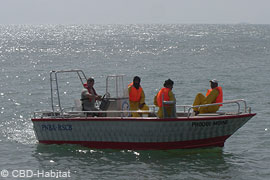 |
|
|
PNBA (Parque National Banc d’Arguin) marine surveillance vessel. |
Today, the Cabo Blanco monk seal population is recovering, and the Cabo Blanco Satellite Reserve, designated as a Special Area of Conservation for Monk Seals by the Action Plan in the Atlantic, is a solid candidate for recolonization if surveillance can guarantee non-disturbance of beaches and cliffs. Therefore, this project has as one of its main objectives the training of guards, also in the use of equipment, including a marine surveillance vessel.
Since the area can be visited by local inhabitants of nearby Nouadhibou, the second city of Mauritania and the economic capital of the country, a visitors centre is also being built here, focusing on the monk seal and the marine environment. The centre will inform visitors about the threatened status of the monk seal, the efforts being undertaken to help its survival, and the contribution local inhabitants can make to achieve this goal. The centre is currently under construction and will be inaugurated in the beginning of 2008. – Ana Maroto, Hamdi M’barek and Pablo Fernández de Larrinoa, CBD-Habitat.
The monk seal sightings network (REDFOM) has been expanded to Spanish vessels that fish in Moroccan fishing grounds in the Atlantic. Of the 79 vessels we were in contact with, 67 are currently collaborating with the project. Together with the 85 contacted in Mauritania, this brings the total of cooperating vessels to 152, while also expanding the monk seal sightings network throughout Saharan fishing grounds.
The network meets two simultaneous objectives: to provide more information about the biology of the species, while bringing fishermen into the conservation process, helping them to understand the importance of the protection of marine biodiversity. – Mercedes Muñoz, Fundación CBD-Habitat.
Mediterranean News continues with Morocco and Turkey...
Copyright © 2007 The Monachus Guardian. All Rights Reserved |